
British Rail Universal Trolley Equipment (BRUTEs) were trolleys used from 1964 until 1999 for sorting, handling and transport by rail of parcels, newspapers, etc.

British Rail Universal Trolley Equipment (BRUTEs) were trolleys used from 1964 until 1999 for sorting, handling and transport by rail of parcels, newspapers, etc.
BRUTEs were a wheeled platform, generally with mesh around three sides of the body, the fourth side being open with canvas (or later plastic) straps for restraint of the load. The front included a panel for notes to be chalked to help sort traffic. A few BRUTEs had just the front, for carrying bulky loads too big for the cage, or two hinged ramps (no sides) to load or unload BRUTEs into railway vans. Each BRUTE had two fixed wheels at the rear and two swivelling caster wheels at the front, with polyurethane tyres and taper bearings. [1] Coupling were at front and rear, the front being a pin, the rear a hinged loop on a sprung shaft. A lever on the front operated brakes on the rear wheels and lifted the coupling pin.

The BRUTE was designed by the BR Materials Handling team, led by John Travers Cosgrove [2] and supported by Gordon Holland. Their first use was on the Western Region on parcels services connecting 20 stations between Paddington, Bristol and Carmarthen. [3] By the end of 1964, the name "British Railways Universal Trolley Equipment" and the acronym "BRUTE" were in use, by which time some 2500 were in use on the Western Region, with 2000 on order for other regions. [4] They were fabricated on a production line at Swindon Works. In August 1964 output was 100 per week, 150 per week two months later, and 200 per week in early 1965. Forty men were employed in their production, most of whom had previously built steam locomotives. All parts were made at Swindon except for the wheels and bearings. [1] The wheels were made by Homa Engineering.[ citation needed ]
Unlike traditional station trolleys, they were loaded each with parcels for a particular destination and wheeled into the train. This saved train waiting time and cut down on handling. They were used until the Red Star Parcels service was discontinued in 1999.

BRUTEs could be carried in most parcels vans or passenger brake coaches with double-width doors, and several types of van were specially modified to carry them. Yellow circular 'BRUTE CIRCUIT ONLY' labels on the side identified them. [5] When TOPS CARKND codes were introduced they had different codes from unmodified vans. [6]
Modified bogie General Utility Vans (GUVs) had hinged beams that folded down inside the double doors to protect them from bursting open if a BRUTE hit them. The steps below the doors were removed as these were easily damaged by careless unloading. [7] They were given TOPS CARKIND NK. [8]
Many four-wheeled British Rail-built Covered Carriage Trucks (CCTs) were fitted with chains inside to stop BRUTEs moving during transit. They were given TOPS CARKIND NP. [8]
Parcels Carrying Van (PCV) E85000 was constructed in 1970 as a BRUTE carrier. It was built from GRP on the underframe of corridor composite Sc15170. It was in service until 1982. [9]
There are some BRUTEs in The Warehouse at the National Railway Museum, York and at the Museum of the Great Western Railway, Swindon.
Two have been preserved at the Keighley & Worth Valley Railway in West Yorkshire.
Eight have been preserved by the Quorn Wagon & Wagon group at the Great Central Railway.

A skid loader, skid-steer loader, SSLs or skidsteer is a small, rigid-frame, engine-powered machine with lift arms that can attach to a wide variety of buckets and other labor-saving tools or attachments.
The Armagh rail disaster happened on 12 June 1889 near Armagh, County Armagh, in Ireland, when a crowded Sunday school excursion train had to negotiate a steep incline; the steam locomotive was unable to complete the climb and the train stalled. The train crew decided to divide the train and take forward the front portion, leaving the rear portion on the running line. The rear portion was inadequately braked and ran back down the gradient, colliding with a following train.

Brake van and guard's van are terms used mainly in the UK, Ireland, Australia and India for a railway vehicle equipped with a hand brake which can be applied by the guard. The equivalent North American term is caboose, but a British brake van and a caboose are very different in appearance, because the former usually has only four wheels, while the latter usually has bogies. German railways employed Brakeman's cabins combined into other cars.
Rail terminology is a form of technical terminology. The difference between the American term railroad and the international term railway is the most significant difference in rail terminology. There are also others, due to the parallel development of rail transport systems in different parts of the world.
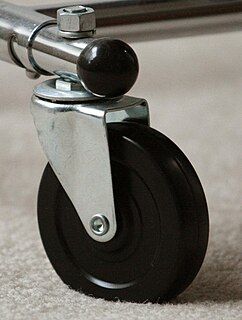
A caster is an undriven wheel that is designed to be attached to the bottom of a larger object to enable that object to be moved.
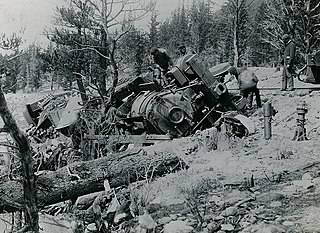
In rail transport, a derailment occurs when a rail vehicle such as a train comes off its rails. Although many derailments are minor, all result in temporary disruption of the proper operation of the railway system and they are a potentially serious hazard.

The Swindon & Cricklade Railway is a heritage railway in Wiltshire, England, that operates on a short section of the old Midland and South Western Junction Railway line between Swindon and Cricklade.

A railway brake is a type of brake used on the cars of railway trains to enable deceleration, control acceleration (downhill) or to keep them immobile when parked. While the basic principle is similar to that on road vehicle usage, operational features are more complex because of the need to control multiple linked carriages and to be effective on vehicles left without a prime mover. Clasp brakes are one type of brakes historically used on trains.
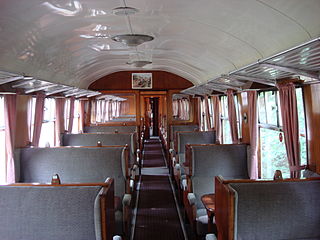
British Railways Mark 1 is the family designation for the first standardised designs of railway carriages built by British Railways (BR) from 1951 until 1974, now used only for charter services on the main lines or on preserved railways.
A RoadRailer is a trailer or semi-trailer that can be hauled on roads by a tractor unit and then by way of a fifth wheel coupling, operate in a unit train on railway lines. The RoadRailer system allows trailers to be pulled by locomotives without the use of flatcars, instead attaching trailers directly to bogies.
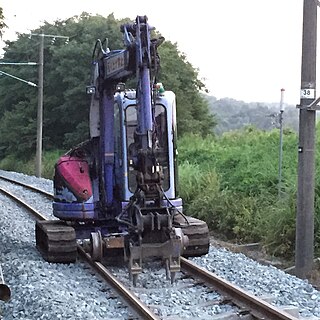
A road–rail vehicle or a rail–road vehicle is a dual-mode vehicle which can operate both on rail tracks and roads. They are also known as two-way vehicles, hi-rail, and rail and road vehicles.
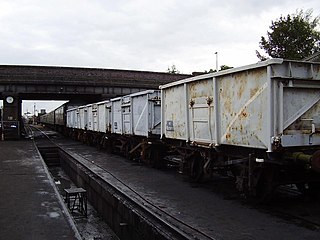
A mineral wagon or coal truck is a small open-topped railway goods wagon used in the United Kingdom and elsewhere to carry coal, ores and other mine products.

11001 was one of the first British Railways diesel locomotives, built in 1949 at British Railways' Ashford railway works. It was designed by O. V. S. Bulleid when he was Chief Mechanical Engineer of the Southern Railway. It was powered by a Paxman RPH Series 1 engine, capable of delivering 500 brake horsepower (370 kW) at 1,250 rpm. It was driven via a Vulcan-Sinclair fluid coupling to an SSS (synchro-self-shifting) Powerflow gearbox. The gearbox provided three forward and reverse gears in either high or low range, with top speed ranging from 5 mph (8 km/h) in 1st gear, low range up to 36 mph (58 km/h). It had a 0-6-0 wheel formation, driven by rods from a rear jackshaft on the final drive, and with Bulleid's favoured BFB wheels.

A bicycle trailer is a motorless wheeled frame with a hitch system for transporting cargo by bicycle. It can greatly increase a bike's cargo capacity, allowing point-to-point haulage of objects up to 4 cubic yards in volume that weigh as much as half a ton.

A horse-drawn vehicle is a mechanized piece of equipment pulled by one horse or by a team of horses. These vehicles typically had two or four wheels and were used to carry passengers and/or a load. They were once common worldwide, but they have mostly been replaced by automobiles and other forms of self-propelled transport.
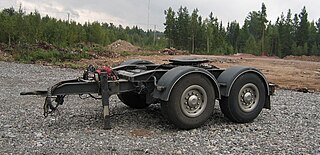
A dolly is an unpowered vehicle designed for connection to a tractor unit, truck or prime mover vehicle with strong traction power.

A semi-trailer is a trailer without a front axle. In the United States, the term is also used to refer to the combination of a truck and a semi-trailer; a tractor-trailer.

The fleet of Great Western Railway wagons was both large and varied as it carried the wide variety of goods traffic on the Great Western Railway (GWR) in the United Kingdom. This was the railway company that operated for the longest period of time in the country and covered a large geographical area that included big cities such as London, industrialised areas including the West Midlands, areas of coal and mineral mining such as South Wales, and Somerset and other important agricultural districts. In 1902 the company owned 59,036 wagons, and by 1926 this had risen to 88,580.
A flatbed trolley a common form of freight transport in distribution environments, for moving bulk loads. Trolleys can aid in reducing effort required to move a load by allowing the user to pull or push instead of lift and carry. A very simple design offers a basic flat platform with four casters and a fixed handle which is used to either push or pull the platform with the load on the platform. Without a flat surface it becomes an open frame trolley and without a handle it is a bogie or dolly.

An airline service trolley, also known as an airline catering trolley, airline meal trolley, or trolley cart, is a small serving cart supplied by an air carrier for use by flight attendants inside the aircraft for transport of beverages, airline meals, and other items during a flight.